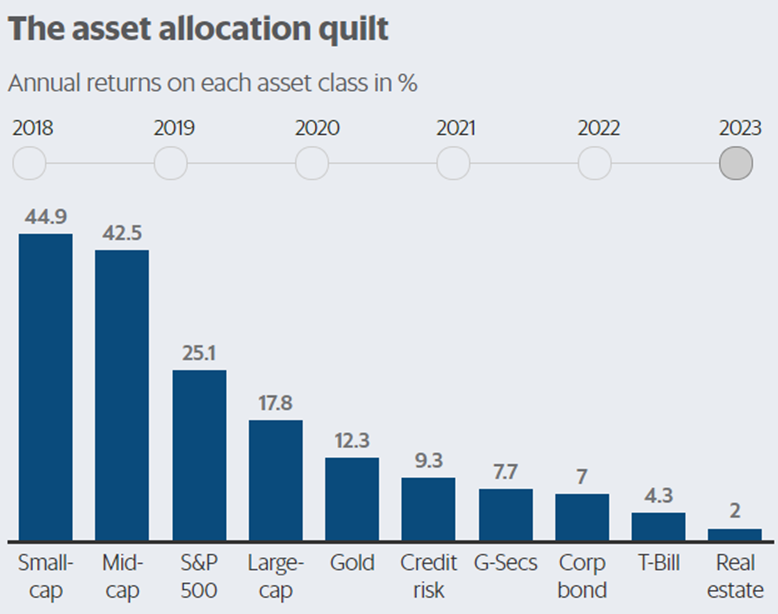Should You Invest In Smallcap Mutual Funds

In December 2023, the smallcap funds got inflows of Rs. 3,857 crores. The inflows were the 2nd highest in the equity category after sectoral/thematic funds. So, why are investors rushing to invest in smallcap MFs, and should you also invest? Let us find out.
Nifty Smallcap 250 Index Performance
One of the reasons why many investors are rushing to invest in smallcap mutual fund schemes is the performance in 2023. The Nifty Smallcap 250 Index was one of the best-performing indices in 2023.
Performance of various asset classes in 2023
Note: The above data is as of 27th December 2023.
The above chart shows how the S&P BSE Smallcap Index outperformed all other asset classes with a gain of a massive 44.9% in 2023.
In the long run, the Nifty Smallcap 250 Index has done well. It has a base date of April 2005 and a base value of 1,000. As of January 2024, the index is trading at levels of around 14,200. So, in the last 19 years, the index has multiplied more than 14 times, creating huge wealth for investors.
19 years of Nifty Smallcap 250 Index growth around 15%
The above chart shows how the Nifty Smallcap 250 Index has grown at a CAGR of around 15% in the last 19 years. These are good returns.
Why Should You Invest in Smallcap Mutual Funds?
In the earlier section, we saw how the Nifty Smallcap 250 Index has created wealth in the long run with the power of compounding. If you also want to benefit from it, invest in smallcap mutual funds. However, before you rush to start investing in smallcap mutual funds, you should understand the following.
A) Smallcap Mutual Funds Carry High Risk
Smallcap mutual funds fall in the high risk – high return category. They have the potential to outperform during bull markets and generate good returns. But, at the same time, during market falls, the draw downs are also bigger and the recovery period is longer.
Performance of Nifty Smallcap 250 Index during bear markets
| Bear market period | Maximum drawdown of Nifty Smallcap 250 Index |
|---|---|
| Jan 08 – Feb 09 | -74% |
| Nov 10 – Dec 11 | -40% |
| Feb 18 – Mar 20 | -56% |
The above table shows how the Nifty Smallcap 250 Index has seen a huge fall in the range of 40% to 74% on three occasions during a bear market period. Also, after the huge fall in 2008-09, it took the Nifty Smallcap 250 Index a long 6.4 years to once again cross the high it made in January 2008.
Similarly, it took the smallcap index more than 3 years to cross the highs made in 2010. So, as a smallcap mutual fund investor, you have to be patient during corrections for the index to recover from the fall and give good returns.
B) Smallcap Companies Are Less Researched and Vulnerable to Manipulation
Few research analysts cover smallcap companies compared to largecap companies. Also, these companies are vulnerable targets for operator groups for pump and dump scams. In these scams, the operators buy the stock at low prices.
They spread false information about the company and inflate (pump) its price artificially. Finally, they dump the stock at higher prices. Eventually, the stock price crashes and retail investors are left holding the stock bought at inflated prices with losses. Besides being less researched, smallcap companies have less liquidity and less institutional holding.
Investing in Smallcap Mutual Funds
In the earlier section, we saw the risks involved in investing in smallcap stocks. At the same time, smallcaps have the potential to give high returns compared to largecaps. Hence, for investing in smallcaps, retail investors should always take the mutual fund route rather than investing directly in smallcap stocks. When investing in smallcap mutual funds, keep the following points in mind.
A) Asset Allocation
While investing, you should follow asset allocation. Different asset classes take turns to outperform each other in the short run. Hence, you should diversify your investment portfolio among asset classes such as equity mutual funds, debt mutual funds, gold, etc.
If your financial goals are more than five years away, within equities, you should further diversify into large, mid, and smallcap mutual funds. Accordingly, you should allocate some portion of your overall and equity portfolio to smallcap mutual funds. Asset allocation will help you earn better risk-adjusted returns.
B) Invest for the Long Term
While investing in smallcap mutual funds, you should always invest for the long term. In the short run, smallcaps can be volatile. During market corrections, smallcaps may experience heavy drawn downs compared to largecaps as seen in the earlier section. Also, when the market recovers, usually largecaps are the first to recover. Midcaps and smallcaps may take longer to recover.
Hence, you need to give sufficient time to your smallcap mutual fund investments to go through multiple economic and business cycles to create wealth for you in the long run. The power of compounding works to your benefit in the long run.
C) Invest Through Sip Mode
While investing in smallcap mutual funds, it is always advisable to invest through the systematic investment plan (SIP) mode rather than lumpsum. In the earlier section, we discussed how smallcaps can experience heavy draw downs and take longer to recover.
During such times, SIPs average out your purchase cost. Later, when the smallcaps recover and start growing faster, you benefit from the higher units accumulated during the downturn.
There have been a few instances when the point-to-point returns for the Nifty Smallcap 250 Index have been 0 in the case of lumpsum investments. However, during the same period, SIPs have given positive returns.
Below are 4 periods (ranging between 1 to 4 years) when point-to-point returns were 0% for lumpsum investments in the Nifty Smallcap 250 Index. However, during the same period, the SIP returns ranged between 18.5% to 40.6% CAGR.
Nifty Smallcap 250 Index returns: Point-to-point lumpsum vs SIP returns
| Period | Point-to-point lumpsum returns | SIP returns |
|---|---|---|
| Dec 07 – Sep 10 | 0% | 40.6% |
| Nov 10 – May 14 | 0% | 18.6% |
| Jan 18 – Jan 21 | 0% | 24.1% |
| Jan 22 – May 23 | 0% | 18.5% |
As seen in the above table, with smallcaps that can experience big draw downs and take higher time to recover, SIP should be the ideal mode of investment.
As your annual income increases, you should increase your SIP amount. You can do that using the step-up SIP option. With step-up SIP, you can increase the monthly investment amount on an annual basis. The increase in SIP amount can be an absolute amount or a percentage of the initial amount. A step-up SIP helps you reach your financial goals faster than a regular SIP.
Smallcaps Can Create Wealth for You
We have seen how smallcap have the potential to do better than largecaps in the long run and can create wealth for you. Hence, to achieve your financial goals, smallcap mutual funds should be a part of your investment portfolio. However, when you invest in smallcap mutual funds, follow asset allocation, invest for the long term, and make SIP your preferred mode of investment.
Your Investing Experts
Relevant Articles
Regular Savings Plan: A Balanced Approach to Stability and Growth
Not every investment in a portfolio is meant to maximise returns. Some are meant to preserve capital, manage volatility, and provide predictability. A regular savings plan serves exactly this role. It is designed for investors who want a more measured approach where stability takes priority, and growth plays a supporting role rather than the lead.
From Coffee to Crorepati: Small Lifestyle Tweaks Gen Z Can Make to Start Investing Early
Gen Z is often told to “stop buying coffee” if they want to invest. But that misses the point. Building wealth isn’t about sacrificing everything you enjoy. It’s about understanding how small, everyday decisions shape long-term habits. Starting early even with modest amounts can quietly make a meaningful difference over time.
Why Comparing Investment Returns Can Be Misleading
At some point, most investors have compared their investment returns with a friend, a colleague, or a number they saw online and wondered why their outcomes looked different. While this instinct is natural, return comparisons are often incomplete and, in many cases, misleading. Understanding why returns differ is far more important than comparing the numbers themselves.




.png)
